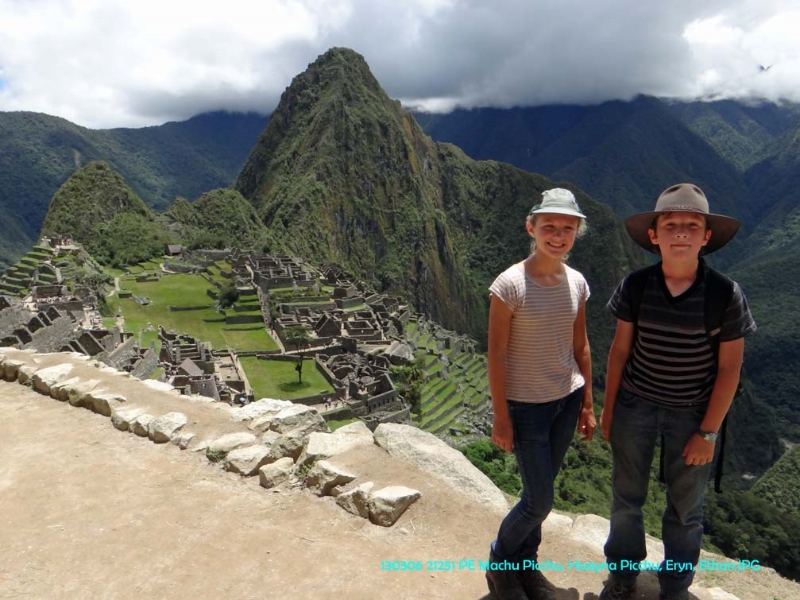Observations
Life after Apartheid – Some South Africans are still figuring out how to deal with prejudices and past injustices from Apartheid. We spoke with several white individuals in the central part of the country who told us about areas considered unsafe to visit because “there are so many black people living there.” And others told us about white people losing farms that had been in their families for many generations because the government wanted to give their land to black families to make up for racial inequalities in the past. Both of these perspectives were sad to hear.
Pannekoek – This Dutch pancake is very popular throughout South Africa. It is usually about 10 to 12 inches in diameter and much thinner than traditional pancakes in the US. They are often rolled with a sweet or savory filling. One favorite way for South Africans to enjoy their pannekoek is with sugar and cinnamon rolled inside and sometimes topped with a light sugar syrup. We enjoyed eating this traditional food at a Pannekoek Restaurant in Drakensberg. Yes, the majority of items on the menu were pannekoek meals. Jerry was the only one in our family who ordered a savory pannekoek—butternut-filled pancakes with a chili sauce. Yummy! The rest of us got our sugar fix with pannekoeks filled with and smothered with chocolate sauce, caramel sauce, bananas, and/or fresh whipped cream.
Challenges
Christmas away from home – We had to put most of our family Christmas traditions on hold for a year. But we were able to continue a couple of our holiday traditions, even though we were south of the equator and experiencing summer weather instead of playing in the snow. My sister graciously sent Eryn and Ethan red stockings that were very similar to the ones they have at home and Santa filled the stockings on Christmas Eve with candy, gifts, and goodies. As part of our Christmas dinner, we prepared two of my favorite traditional dishes: pumpkin pie and cranberry jello salad. The pie recipe I used was for fresh pumpkin, since you cannot buy canned pumpkin in Cape Town. So the spice, sugar, and milk ratio was a bit different than my preferred recipe. I used my mom’s cranberry salad recipe and found all the ingredients to make this yummy dish.
Car accident on our last day in South Africa – A traffic cop signaled us to enter a busy intersection that was not controlled by traffic signals, or robots as they are called in South Africa. Unfortunately a driver coming from the road to our left did not heed his yield sign. He entered the intersection right in front of us and we could not avoid hitting him. No one was hurt, no air bags deployed and the other driver was polite and reasonable, fortunately. But we still had a lot of paperwork to complete – police report, rental car company reports, credit card company reports, etc. Our rental car company did not seem to care which vehicle caused the accident. They only stressed the importance of filing a police report and completing their paperwork. If the other driver did not file a police report he is considered at fault and then his rental car company has to automatically pay for repairs of both vehicles, regardless of how the accident occurred.
Favorites
Kruger National Park – We were able to spend a whole week at Kruger and stayed in five different rest camps, but we only travelled to a fraction of the 7,523 square miles of the park. We saw a wide variety of animals, including three uncommon sightings: wild dogs, two leopards and a cheetah with her five cubs. One unique aspect of our visit was the abundance of wild flowers and not-so-tall green grass. Neither I nor Jerry had visited Kruger before during the spring season.
Visit with Dennis and Maritjie – Jerry met Dennis during his student missionary year at Helderberg College in the 1980’s and has kept in touch with him over the years. Dennis, a pastor, and Maritjie, a nurse, live outside the small town of Koster, which was founded by Maritjie’s family several generations ago. We had a good time touring their family’s farm and the surrounding sights. It was good to visit places with people who were familiar with the area and could give us added perspective.
Drakensberg Mountains – This forested area reminded us of Oregon, including the cold air, rain and fog. But all the forests in South Africa are planted, rather than naturally occurring. So, the trees are in nice straight rows and all about the same height, which takes a bit away from the out-in-nature feel.
Table Mountain – This is truly one of the most beautiful places in the world. The view of the mountain from Cape Town with a bit of cloud (tablecloth) over the top never gets old. And when looking out over Cape Town, the ocean, and the surrounding area from the summit on a clear day, you can’t help but feel that it definitely deserves its new title: one of the seven natural wonders of the world.

